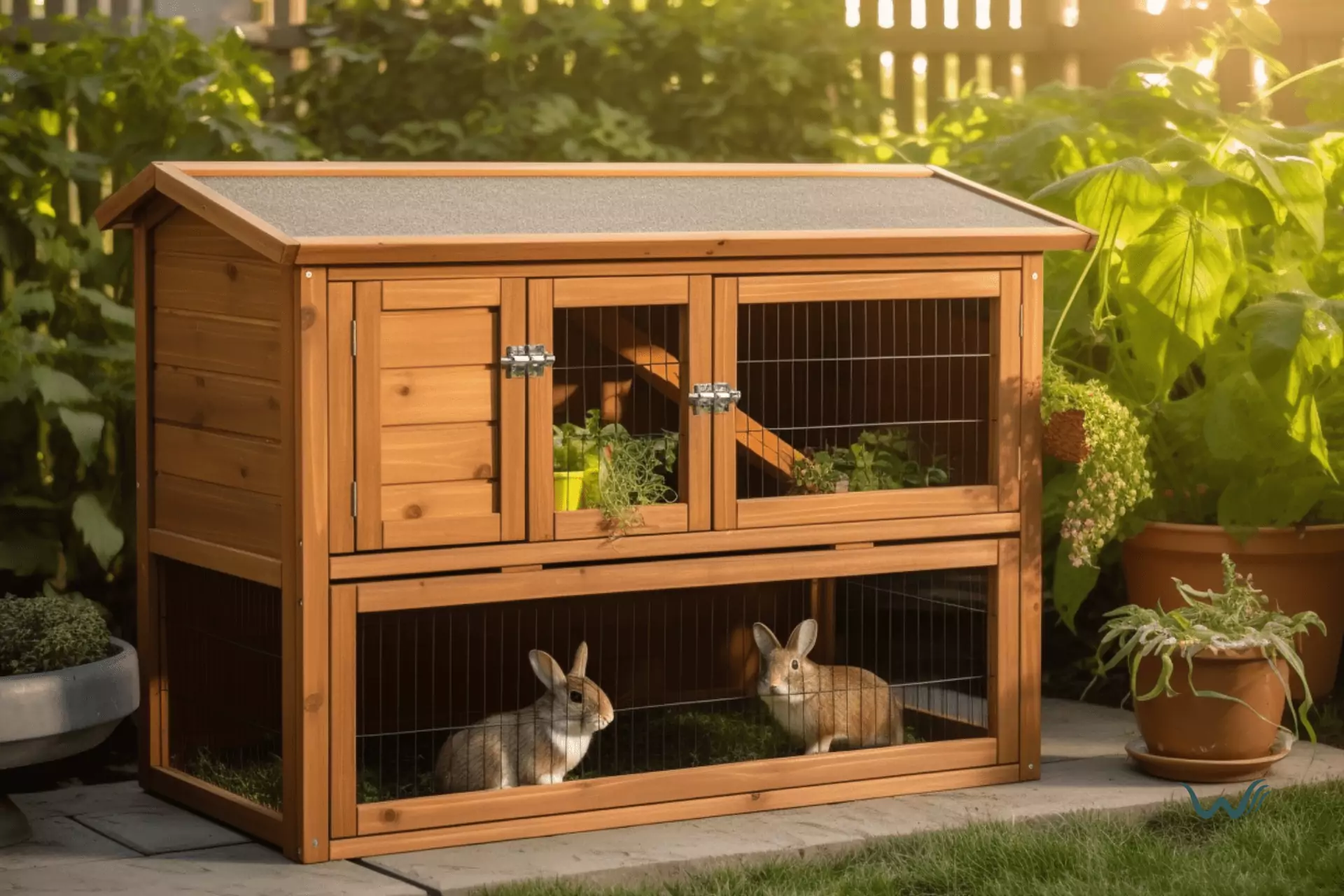

Should Pet Rabbits Live Indoors Or Outdoors?
by Haley Mills
Last updated: April 23, 2024
Verified and Approved by:
Angela Morris,
MSW, LCSW
Fact Checked

When it comes to deciding where to house your pet rabbit, there are two main options to consider: indoors or outdoors. Both choices have advantages and disadvantages, and it ultimately depends on your furry friend’s specific needs and preferences.
In this article, we will explore the considerations for both indoor and outdoor living for pet rabbits, highlighting the benefits of each and offering tips on how to ensure their safety and well-being in either environment.
Indoor living can provide a controlled and safe environment for your pet rabbit. It allows you to monitor their behavior, diet, and health closely, ensuring they receive the necessary care and attention. Additionally, indoor living can protect rabbits from extreme weather conditions, predators, and diseases that may be present in outdoor environments.
Try to create a suitable indoor habitat that mimics their natural instincts and provides enough space for exercise and mental stimulation. By understanding the factors to consider for both indoor and outdoor living, you can make an informed decision that best suits the needs of your beloved pet rabbit.
Considerations for Indoor Rabbit Living
Indoor rabbit behavior is generally more predictable and manageable compared to outdoor rabbits. Rabbits that live indoors tend to be more socialized and accustomed to human interaction. They’re often litter-trained, which makes cleaning up after them much easier.
Indoor rabbits also have less exposure to predators and extreme weather conditions, ensuring their safety and well-being.
In addition to behavioral advantages, indoor living has several health benefits for rabbits. Indoor rabbits are protected from common outdoor dangers such as parasites, diseases, and poisonous plants. They’re less likely to contract illnesses or get injured. Furthermore, indoor living provides a controlled environment where the temperature and humidity can be regulated, preventing the risk of heat stroke or hypothermia. Indoor rabbits also have a lower chance of developing respiratory issues caused by dust, pollen, or other allergens commonly found outdoors.
Benefits of Outdoor Rabbit Habitats
One of the main advantages of outdoor living is the ample space it provides. In an outdoor habitat, rabbits can roam and explore, essential for their physical and mental well-being. They can hop, run, and dig to their heart’s content, mimicking their natural behaviors in the wild.
Additionally, outdoor habitats often offer more opportunities for enrichment, such as tunnels, hiding spots, and natural vegetation, which can keep rabbits stimulated and engaged.
Another significant benefit of outdoor living for rabbits is the exposure to fresh air and natural sunlight. Outdoor habitats allow rabbits to breathe in clean, unpolluted air, which can contribute to their overall respiratory health. Sunlight exposure is also crucial for rabbits, as it helps them produce vitamin D, essential for strong bones and a healthy immune system. Natural sunlight can also improve a rabbit’s mood and reduce the risk of vitamin deficiencies and osteoporosis.
Outdoor habitats may expose rabbits to predators, extreme weather conditions, and other environmental hazards. Providing a secure and protected outdoor space for rabbits, such as a predator-proof enclosure or a rabbit hutch with a sturdy roof is crucial. Regular monitoring and appropriate shelter options should also be provided to ensure the rabbits’ safety and well-being.
Ensuring Safety and Security Indoors
One way to ensure the safety and security of your furry friends is by creating a rabbit-proof environment indoors. Indoor rabbit-proofing techniques are essential to prevent accidents and injuries.
To begin with, it’s crucial to secure any electrical cords or wires that may be within the rabbit’s reach. Rabbits naturally tend to chew, and electrical cords can be hazardous if they’re chewed through. Use cord protectors or encase the cords in PVC piping to prevent your rabbit from accessing them.
Another important aspect of indoor rabbitproofing is ensuring that any toxic plants or household chemicals are kept out of reach. Rabbits have sensitive digestive systems and can easily become sick or even die if they ingest something harmful. Keep all cleaning supplies, pesticides, and medications stored in secure cabinets or high shelves.
Additionally, providing your rabbit with a safe and comfortable living space is crucial. This includes providing them with a spacious enclosure or pen that is escape-proof. Ensure there are no small openings or gaps your rabbit can squeeze through. Cover any sharp edges or corners your rabbit may accidentally bump into is also a good idea.
Creating a Suitable Outdoor Environment
Rabbits need plenty of space to hop, run, and explore, so designing an enclosure large enough to accommodate their natural behaviors is crucial.
The enclosure should be securely fenced to prevent any escapes or predator attacks. Additionally, it should have a solid bottom to protect the rabbits from digging predators and provide a safe and comfortable surface for them to walk on.
In addition to providing a secure enclosure, create an environment that offers natural stimulation for pet rabbits. This can be achieved by adding various elements such as tunnels, hiding spots, and elevated platforms. Rabbits love to dig, so providing a digging box filled with soil or sand can be a great way to satisfy this natural behavior. Adding a variety of toys and chewable items can also help keep rabbits mentally and physically stimulated.
Can Pet Rabbits Live in a Luxurious Outdoor House Like Paris Hilton’s Dog?
Pet rabbits can indeed live in a luxurious outdoor house like Paris Hilton’s luxury dog house. With proper design and amenities, rabbits can enjoy the comfort and style of a high-end living space just like any other pampered pet. A spacious and well-designed outdoor enclosure can provide a safe and enjoyable environment for pet rabbits.
Finding the Best Living Arrangement for Your Pet Rabbit
Finding the best living arrangement for your furry friend involves considering various factors. Regarding pet rabbits, there is often a debate about whether they should live indoors or outdoors. Both options have pros and cons, and it ultimately depends on your specific circumstances and your rabbit’s needs.
One factor to consider is the health concerns associated with each living arrangement. Indoor rabbits are generally protected from extreme temperatures, predators, and potential diseases. They’re also less likely to be exposed to parasites such as fleas and ticks. However, indoor rabbits may still be susceptible to respiratory issues due to poor air quality or allergens in the home. Keep their living space clean and well-ventilated to minimize these risks.
On the other hand, outdoor living can provide rabbits a more natural environment and ample space to exercise and explore. They can graze on fresh grass and enjoy the sunlight. However, outdoor rabbits are more vulnerable to predators, extreme weather conditions, and infectious diseases. It’s crucial to provide them with a secure and predator-proof enclosure and regular veterinary care to prevent and address any health issues.
Another factor to consider is socialization opportunities. Rabbits are social animals and thrive on companionship. Indoor rabbits have the advantage of being able to interact with their human family members daily, which can help prevent loneliness and provide mental stimulation. On the other hand, outdoor rabbits may have the opportunity to interact with other rabbits if they’re housed in a compatible group. This can provide them with companionship and a more enriching social environment.
Frequently Asked Questions
Are there any health risks associated with keeping rabbits indoors?
There are both pros and cons to keeping rabbits indoors. On the positive side, indoor rabbits are protected from predators and extreme temperatures. However, indoor environments require careful attention to ensure proper ventilation, cleanliness, and mental stimulation for the rabbits’ well-being.
What are the potential dangers of housing rabbits outdoors?
Potential dangers of housing rabbits outdoors include predators such as foxes and birds of prey. Harsh weather conditions can also be a risk. Additionally, rabbits may suffer from lack of socialization and limited space to roam and exercise.
Can rabbits be litter trained if they are kept indoors?
Yes, rabbits can be litter trained if kept indoors. Training techniques include using a litter box with rabbit-safe litter, positive reinforcement, and consistency. Providing a designated outdoor play area for indoor rabbits offers additional mental and physical stimulation.
How often should rabbits be allowed to roam freely outside if they are kept indoors?
The optimal outdoor exercise routine for indoor rabbits involves allowing them to roam freely outside for at least 2-3 hours a day, while ensuring their safety indoors. This balance promotes their physical and mental well-being.
Are there any specific breeds of rabbits that are better suited for indoor or outdoor living?
When comparing the temperament of indoor and outdoor rabbits, it is important to consider the specific breed. Some breeds, like the Holland Lop, are more suited for indoor living due to their docile nature. However, providing both indoor and outdoor spaces can offer rabbits the benefits of stimulation and fresh air.
Certify Your Emotional Support Animal Today

Why You Can Rely on Us?
At Wellness Wag, we believe your pet deserves care rooted in both science and compassion. Each article is carefully researched, written in clear language for pet owners, and then reviewed by qualified professionals to ensure the information is evidence-based, current, and practical for real-life care. Our goal is to help you feel confident in making informed decisions about your pet’s health and well-being.
Reviewed by
Angela Morris, MSW, LCSW
Angela is a licensed clinical social worker with 20 years of experience in patient advocacy and community mental health. She has assisted numerous clients with ESA evaluations and brings a deep understanding of disability accommodations, ensuring that all information is accurate, supportive, and practical.

Written by :
Haley Mills
Last Updated :
April 23, 2024










